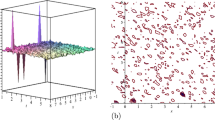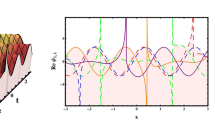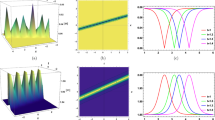Abstract
In this study, we have focused on finding soliton solutions of the cubic–quartic Fokas–Lenells equation, which models the nonlinear pulse transmission through optical fiber, is a pretty new and updated model. The main motivation of this study is to produce new solutions with previously unused methods for data transmission models in fiber optic cables together with the developing technology, which has been used very frequently today. We have used three different efficient analytical methods, namely, the Sinh–Gordon expansion method, enhanced modified extended tanh expansion method and unified Riccati equation expansion method. By modifying our proposed method and using it effectively, we have obtained much more optical solutions. We have supported the results with the 3D surface, 2D and contour plots of the soliton solutions, such as singular, periodic, periodic-singular, dark and M-shaped solitons. The originality of the method we propose is that it has never been used before. With the innovation of the method, we have obtained M-shaped solitons, which are very rarely obtainable in soliton waves. On the other hand, enhanced modified extended tanh expansion method have provided us more extra solutions. As the last and most important part, in order to examine physical behaviors, we have investigated the effect of the coefficient of the fourth order dispersion parameter on wave propagation by presenting the graphical representation.








Similar content being viewed by others
Availability of data and materials
All data generated or analyzed during this study are included in this article.
References
Akinyemi, L., Şenol, M., Mirzazadeh, M., Eslami, M.: Optical solitons for weakly nonlocal Schrödinger equation with parabolic law nonlinearity and external potential. Optik 230, 166281 (2021). https://doi.org/10.1016/j.ijleo.2021.166281
Akram, G., Mahak, N.: Traveling wave and exact solutions for the perturbed nonlinear Schrödinger equation with Kerr law nonlinearity. Eur. Phys. J. Plus 133(6), 1–9 (2018). https://doi.org/10.1140/epjp/i2018-12061-7
Al-Qarni, A.A., Bakodah, H.O., Alshaery, A.A., Biswas, A., Yıldırım, Y., Moraru, L., Moldovanu, S.: Numerical simulation of cubic–quartic optical solitons with perturbed Fokas–Lenells equation using improved adomian decomposition algorithm. Mathematics 10(1), 138 (2022). https://doi.org/10.3390/math10010138
Biswas, A.: Dispersion-managed solitons in optical fibres. J. Opt. A Pure Appl. Opt. 4(1), 84–97 (2002). https://doi.org/10.1088/1464-4258/4/1/315
Biswas, A., Arshed, S.: Application of semi-inverse variational principle to cubic-quartic optical solitons with kerr and power law nonlinearity. Optik 172, 847–850 (2018). https://doi.org/10.1016/j.ijleo.2018.07.105
Biswas, A., Yildirim, Y., Yasar, E., Zhou, Q., Moshokoa, S.P., Belic, M.: Optical solitons for Lakshmanan–Porsezian–Daniel model by modified simple equation method. Optik 160, 24–32 (2018). https://doi.org/10.1016/j.ijleo.2018.01.100
Biswas, A., Dakova, A., Khan, S., Ekici, M., Moraru, L., Belic, M.: Cubic–quartic optical soliton perturbation with Fokas–Lenells equation by semi-inverse variation. Semicond. Phys. Quantum Electron. Optoelectron. 24(4), 431–435 (2021). https://doi.org/10.15407/spqeo24.04.431
Chen, W., Wang, T., Wang, J., Mu, Y.: Dynamics of interacting Airy beams in the fractional Schrödinger equation with a linear potential. Opt. Commun. 496, 127136 (2021). https://doi.org/10.1016/j.optcom.2021.127136
Cinar, M., Onder, I., Secer, A., Sulaiman, T.A., Yusuf, A., Bayram, M.: Optical solitons of the (2+1)-dimensional Biswas–Milovic equation using modified extended tanh-function method. Optik 245, 167631 (2021). https://doi.org/10.1016/j.ijleo.2021.167631
Dey, K., Roy, S., Kishore, P., Shankar, M.S., Buddu, R.K., Ranjan, R.: Analysis and performance of edge filtering interrogation scheme for FBG sensor using SMS fiber and OTDR. Results Opt. 2, 100039 (2021). https://doi.org/10.1016/j.rio.2020.100039
Esen, H., Ozdemir, N., Secer, A., Bayram, M., Sulaiman, T.A., Yusuf, A.: Solitary wave solutions of chiral nonlinear Schrödinger equations. Mod. Phys. Lett. B 35, 1 (2021a). https://doi.org/10.1142/S0217984921504728
Esen, H., Ozdemir, N., Secer, A., Bayram, M.: On solitary wave solutions for the perturbed Chen–Lee–Liu equation via an analytical approach. Optik 245, 167641 (2021b). https://doi.org/10.1016/j.ijleo.2021.167641
Gao, X.Y., Guo, Y.J., Shan, W.R.: Optical waves/modes in a multicomponent inhomogeneous optical fiber via a three-coupled variable-coefficient nonlinear Schrödinger system. Appl. Math. Lett. 120, 107161 (2021). https://doi.org/10.1016/j.aml.2021.107161
Houwe, A., Abbagari, S., Nisar, K.S., Inc, M., Doka, S.Y.: Influence of fractional time order on W-shaped and Modulation Instability gain in fractional Nonlinear Schrödinger Equation. Results Phys. 28, 104556 (2021). https://doi.org/10.1016/j.rinp.2021.104556
Kaur, L., Wazwaz, A.M.: Optical solitons for perturbed Gerdjikov–Ivanov equation. Optik 174, 447–451 (2018). https://doi.org/10.1016/j.ijleo.2018.08.072
Kudryashov, N.A.: A generalized model for description of propagation pulses in optical fiber. Optik 189, 42–52 (2019). https://doi.org/10.1016/j.ijleo.2019.05.069
Kumar, V.: Optical solitons and modulation instability for cubic–quartic Fokas–Lenells equation. Partial Differ. Equ. Appl. Math. 5, 100328 (2022). https://doi.org/10.1016/j.padiff.2022.100328
Mahak, N., Akram, G.: Extension of rational sine-cosine and rational sinh–cosh techniques to extract solutions for the perturbed NLSE with Kerr law nonlinearity. Eur. Phys. J. Plus 134(4), 1–10 (2019a). https://doi.org/10.1140/epjp/i2019-12545-x
Mahak, N., Akram, G.: Novel approaches to extract soliton solutions of the (1 + 1) dimensional Fokas–Lenells equation by means of the complex transformation. Optik 192, 162912 (2019b). https://doi.org/10.1016/j.ijleo.2019.06.012
Mahak, N., Akram, G.: Exact solitary wave solutions of the (1 + 1)-dimensional Fokas–Lenells equation. Optik 208, 164459 (2020a). https://doi.org/10.1016/j.ijleo.2020.164459
Mahak, N., Akram, G.: The modified auxiliary equation method to investigate solutions of the perturbed nonlinear Schrödinger equation with Kerr law nonlinearity. Optik 207, 164467 (2020b). https://doi.org/10.1016/j.ijleo.2020.164467
Mathanaranjan, T., Rezazadeh, H., Şenol, M., Akinyemi, L.: Optical singular and dark solitons to the nonlinear Schrödinger equation in magneto-optic waveguides with anti-cubic nonlinearity. Opt. Quantum Electron. 53(12), 1–16 (2021). https://doi.org/10.1007/s11082-021-03383-z
Mirzazadeh, M., Ekici, M., Sonmezoglu, A., Eslami, M., Zhou, Q., Kara, A.H., Milovic, D., Majid, F.B., Biswas, A., Belić, M.: Optical solitons with complex Ginzburg–Landau equation. Nonlinear Dyn. 85(3), 1979–2016 (2016). https://doi.org/10.1007/s11071-016-2810-5
Muhibbullah, M.: Phase difference between electric and magnetic fields of the electromagnetic waves. Optik 247, 167862 (2021). https://doi.org/10.1016/j.ijleo.2021.167862
Neirameh, A., Parvaneh, F.: Analytical solitons for the space-time conformable differential equations using two efficient techniques. Adv. Differ. Equ. 2021(1), 277 (2021). https://doi.org/10.1186/s13662-021-03439-0
Onder, I., Secer, A., Ozisik, M., Bayram, M.: On the optical soliton solutions of Kundu–Mukherjee–Naskar equation via two different analytical methods. Optik 257, 168761 (2022). https://doi.org/10.1016/j.ijleo.2022.168761
Ozisik, M., Cinar, M., Secer, A., Bayram, M.: Optical solitons with Kudryashov’s sextic power-law nonlinearity. Optik 261, 169202 (2022). https://doi.org/10.1016/J.IJLEO.2022.169202
Rizvi, S.T., Seadawy, A.R., Younis, M., Ahmad, N., Zaman, S.: Optical dromions for perturbed fractional nonlinear Schrödinger equation with conformable derivatives. Opt. Quantum Electron. 53(8), 1–13 (2021). https://doi.org/10.1007/s11082-021-03126-0
Saha, M., Sarma, A.K., Biswas, A.: Dark optical solitons in power law media with time-dependent coefficients. Phys. Lett. A 373(48), 4438–4441 (2009). https://doi.org/10.1016/J.PHYSLETA.2009.10.011
Sirendaoreji: Unified Riccati equation expansion method and its application to two new classes of Benjamin-Bona-Mahony equations. Nonlinear Dyn. 89(1), 333–344 (2017). https://doi.org/10.1007/s11071-017-3457-6
Topkara, E., Milovic, D., Sarma, A.K., Zerrad, E., Biswas, A.: Optical solitons with non-Kerr law nonlinearity and inter-modal dispersion with time-dependent coefficients. Commun. Nonlinear Sci. Numer. Simul. 15(9), 2320–2330 (2010). https://doi.org/10.1016/j.cnsns.2009.09.029
Triki, H., Wazwaz, A.M.: Combined optical solitary waves of the Fokas–Lenells equation. Waves Random Complex Media 27(4), 587–593 (2017). https://doi.org/10.1080/17455030.2017.1285449
Yan, X., Peng, X., Qin, Y., Xu, Z., Xu, B., Li, C., Zhao, N., Li, J., Ma, Q., Zhang, Q.: Classification of plastics using laser-induced breakdown spectroscopy combined with principal component analysis and K nearest neighbor algorithm. Results Opt. 4, 100093 (2021). https://doi.org/10.1016/j.rio.2021.100093
Yang, D.Y., Tian, B., Qu, Q.X., Li, H., Zhao, X.H., Chen, S.S., Wei, C.C.: Darboux-dressing transformation, semi-rational solutions, breathers and modulation instability for the cubic–quintic nonlinear Schrödinger system with variable coefficients in a non-Kerr medium, twin-core nonlinear optical fiber or waveguide. Phys. Scr. 96(4), 045210 (2021). https://doi.org/10.1088/1402-4896/abbd6d
Yıldırım, Y., Biswas, A., Dakova, A., Khan, S., Moshokoa, S.P., Alzahrani, A.K., Belic, M.R.: Cubic–quartic optical soliton perturbation with Fokas–Lenells equation by sine-Gordon equation approach. Results Phys. 26, 104409 (2021). https://doi.org/10.1016/j.rinp.2021.104409
Yu, F., Liu, C., Li, L.: Broken and unbroken solutions and dynamic behaviors for the mixed local-nonlocal Schrödinger equation. Appl. Math. Lett. 117, 107075 (2021). https://doi.org/10.1016/j.aml.2021.107075
Zayed, E.M., Alngar, M.E., Biswas, A., Asma, M., Ekici, M., Alzahrani, A.K., Belic, M.R.: Pure-cubic optical soliton perturbation with full nonlinearity by unified Riccati equation expansion. Optik 223, 165445 (2020). https://doi.org/10.1016/j.ijleo.2020.165445
Zayed, E.M., Alngar, M.E., Biswas, A., Yıldırım, Y., Khan, S., Alzahrani, A.K., Belic, M.R.: Cubic-quartic optical soliton perturbation in polarization-preserving fibers with Fokas–Lenells equation. Optik 234, 166543 (2021). https://doi.org/10.1016/j.ijleo.2021.166543
Funding
No funding was received to assist with the preparation of this manuscript.
Author information
Authors and Affiliations
Contributions
Ismail Onder and Muslum Ozisik conceived of the presented idea. Aydin Secer developed the theory and performed the comp ations. Mustafa Bayram verified the analytics l methods. Mustafa Bayram supervised the findings of this work. All authors discussed the results and contributed t the final manuscript. Aydin Secer and Mustafa Bayram prepared all figures. Aydin Secer and Muslum Ozisik planned and carried out the simulations. All authors discussed the results and commented on the manuscript and Mustafa Bayram contributed to the design and implementation of the research, to the analysis of the supervised work. All authors reviewed the manuscript.
Corresponding author
Ethics declarations
Conflict of interest
The authors declare that there is no conflict of interest whatsoever.
Additional information
Publisher's Note
Springer Nature remains neutral with regard to jurisdictional claims in published maps and institutional affiliations.
This article is part of the Topical Collection on Quantum technology, Quantum walks and quantum image processing: Emerging Trends, Issues and Challenges.
Guest edited by Ahmed Abd El-Latif and Salvador Venegas-Andraca.
Rights and permissions
Springer Nature or its licensor holds exclusive rights to this article under a publishing agreement with the author(s) or other rightsholder(s); author self-archiving of the accepted manuscript version of this article is solely governed by the terms of such publishing agreement and applicable law.
About this article
Cite this article
Onder, I., Secer, A., Ozisik, M. et al. Obtaining optical soliton solutions of the cubic–quartic Fokas–Lenells equation via three different analytical methods. Opt Quant Electron 54, 786 (2022). https://doi.org/10.1007/s11082-022-04119-3
Received:
Accepted:
Published:
DOI: https://doi.org/10.1007/s11082-022-04119-3




